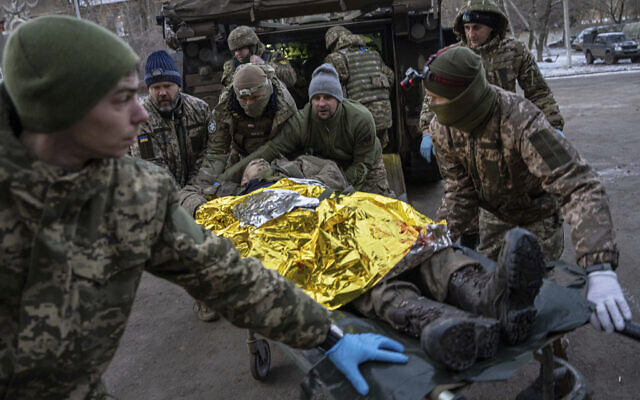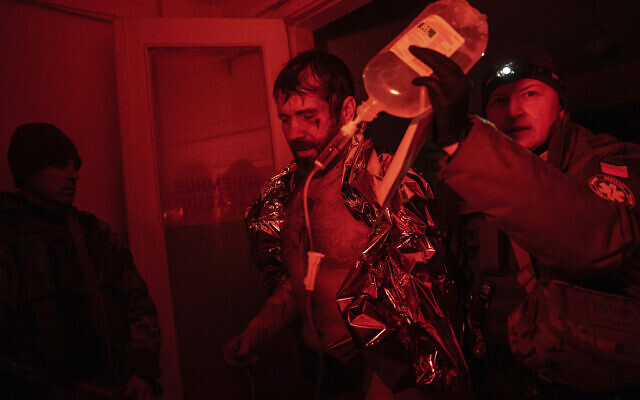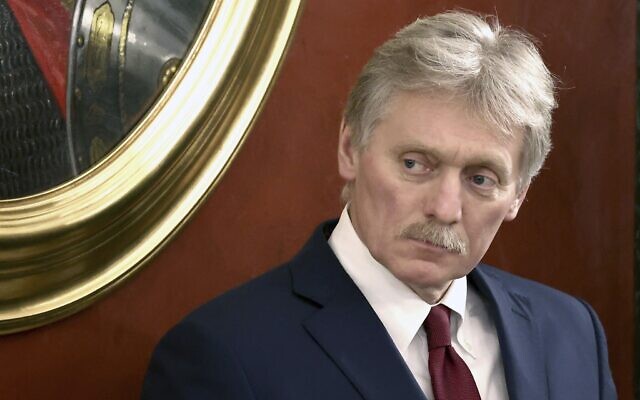KYIV, Ukraine (AP) — Ukrainian officials say Russian forces are stepping up their assault against Ukrainian positions around the ruined city of Bakhmut, bringing new levels of death and destruction to the grinding grind in months of fighting for control of eastern Ukraine. which is part of the Moscow Comprehensive War.
“Everything is completely destroyed. There are almost no lives left,” Ukrainian President Volodymyr Zelensky said late Monday of the scene around Bakhmut and the nearby Donetsk province town of Soledar.
Zelensky said, “The whole land near Soledar is covered with the corpses of the occupiers and the marks of the attacks.” “It looks like madness.”
The Kremlin, whose invasion of its neighbor 10-and-a-half months ago has suffered several setbacks, is hungry for victory. Russia illegally annexed Donetsk and three other Ukrainian provinces in September, but its troops have struggled to advance.
After Ukrainian forces captured the southern city of Kherson in November, fighting heated up around Bakhmut.
Ukraine’s Deputy Defense Minister Hanna Malyar said that Russia has thrown “a large number of stormtrooper groups” into the battle for the city. “The enemy is literally advancing over the bodies of their own soldiers and using artillery, rocket launchers and mortars extensively and killing their own soldiers,” he said.

Ukrainian military medics carry a wounded Ukrainian soldier evacuated from the battlefield at a hospital in the Donetsk region of Ukraine, January 9, 2023. The soldier did not survive. (AP Photo / Evgeny Maloletka)
Pavlo Kirilenko, the Kyiv-appointed governor of the Donetsk region, on Tuesday described the Russian offensive on Soledar and Bakhmut as relentless.
“The Russian military is turning Ukrainian cities into rubble, using all types of weapons in its scorched-earth strategy,” Kirilenko said in televised remarks. “Russia is waging a war without rules, resulting in civilian death and suffering.”
Wounded soldiers receive round-the-clock emergency treatment at a Ukrainian medical stabilization center near the front line around Bakhmut. Medics fought for 30 minutes on Monday to save a soldier, but his injuries were too serious.
Another soldier was hit in the head after his helmet was hit. Medics quickly stabilized him for transfer to a military hospital.
“We fight to the end to save a life,” Kostyantin Vasilkevich, a surgeon and the center’s coordinator, told The Associated Press. “Of course, it hurts when it is not possible to save them.”
The Moscow-backed leader of the occupied regions of Donetsk said on Tuesday that Russia’s forces were “very close” to capturing Soledar. But the gains were coming “at a very high cost”, Denis Pushilin told Russian state TV.
Control of the city, Pushilin said, would create “good prospects” for Bakhmut as well as a city further north, where Ukrainian fortifications are also quite serious.
Britain’s Ministry of Defense concurred with that assessment of the war’s development. Russian troops along with troops from the Russian private military contractor, Wagner Group, have advanced into Soledar and are “likely to take control of most of the settlement,” the ministry tweeted on Tuesday.
On the outskirts of Bakhmut. AFU artillery units hit a Russian ammunition depot and enemy personnel who were trying to hide in the hangar. pic.twitter.com/fQR4cMFtjI
– Christmas ???????? , (@noelreports) January 10, 2023
It said that taking Soledar, 10 kilometers (6 mi) north of Bakhmut, was Moscow’s immediate military objective and part of a strategy to encircle Bakhmut. But it said that “Ukrainian forces maintain stable defensive lines in depth and control of supply routes”.
The leader of the Wagner Group, Dmitry Prigozhin, confirmed in a post on a Russian social media platform on Tuesday that his forces were fighting in the area and acknowledged “heavy fighting” in Soledar against a Ukrainian army he said “bravely fights.”
A Western official, speaking on condition of anonymity, said the Wagner Group “has moved from a major side of Russia’s war to a major component of the conflict,” adding that its forces now make up a quarter of Russian fighters. is in form.
British intelligence reports state that an extraordinary feature of the fighting near Bakhmut is that some of it took place around the entrance to disused salt mine tunnels, which run for some 200 kilometers (120 mi).
“Both sides are likely concerned that [the tunnels] Can be used for infiltration behind their borders,” it said.

A Ukrainian military doctor helps his wounded comrade evacuated from the battlefield at a hospital in the Donetsk region, Ukraine, January 9, 2023. (AP Photo/Evgeny Maloletka)
In Russia, two signs emerged on Tuesday that authorities are grappling with military shortcomings revealed during the conflict in Ukraine.
Russian Defense Minister Shoigu, whose performance has been strongly criticized in some Russian circles but who has retained the confidence of Russian President Vladimir Putin, said on Tuesday that his military would use its experience in Ukraine to improve combat training. Will do
Shoigu said military communications and control systems would be improved using artificial intelligence and soldiers would be given better tactical gear and equipment.
Other signs of trouble include Russia’s production of weapons and other supplies for its military needs for the fight in Ukraine. Dmitry Medvedev, deputy head of Russia’s Security Council, warned that officials who failed to meet deadlines for such items could face criminal charges.
Putin last month appointed Medvedev to head a new commission trying to resolve the army’s supply problems. Several reports have suggested that Russia is running low on some weapons and is sending some troops into battle with inadequate equipment and clothing.
Part of the Kremlin’s challenge is keeping up with the weapons and supplies that Western allies have provided to Ukraine. Kremlin spokesman Dmitry Peskov said Tuesday that NATO members “have become one party in the conflict by pumping weapons, technology and intelligence data into Ukraine.”

Kremlin spokesman Dmitry Peskov attends a press conference of Russian President Vladimir Putin following a meeting of the State Council on implementing youth policy in the current circumstances at the Kremlin on December 22, 2022 in Moscow, Russia. (Valery Sharifulin, Sputnik, Kremlin Pool) Photo via AP)
Fierce fighting has been witnessed in several front-line cities in eastern Ukraine’s Donetsk and Luhansk provinces in recent months.
Together, the provinces make up the Donbass, a vast industrial region bordering Russia that Putin identified as a focus from the beginning of the war and where Moscow-backed separatists have fought since 2014.
During the summer the Russians’ fierce eastern offensive captured almost the whole of Luhansk. Donetsk escaped the same fate, and the Russian army subsequently poured manpower and resources around Bakhmut.
The capture of Bakhmut would disrupt Ukraine’s supply lines and open a path for Russian forces to advance towards Kramatorsk and Sloviansk, key Ukrainian strongholds in Donetsk.
Like Mariupol and other disputed towns, Bakhmut has endured a long siege without water and electricity even before Moscow launched a massive offensive to disconnect public utilities across Ukraine.
Kirilenko, the governor of the Donetsk region, estimated more than two months ago that 90 percent of Bakhmut’s pre-war population of more than 70,000 had fled as Moscow focused on seizing the entirety of Donbass.
Ukraine’s presidential office said at least four civilians were killed and another 30 wounded in Russian shelling between Monday and Tuesday.
The governor of the southern Mykolaiv region, Vitaly Kim, said the Russian military shelled the port of Ochakiv and its surrounding area late on Monday and again in the early hours of Tuesday. He said 15 people, including a two-year-old child, were injured in Monday’s shelling.